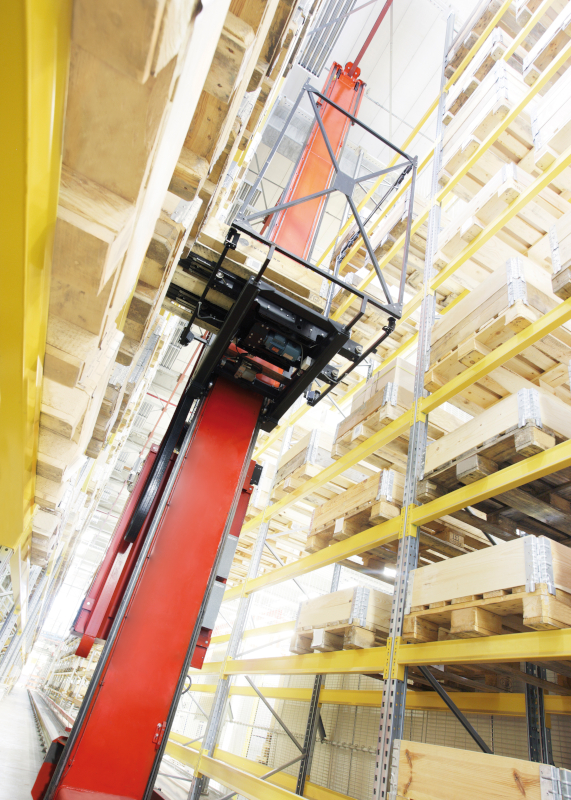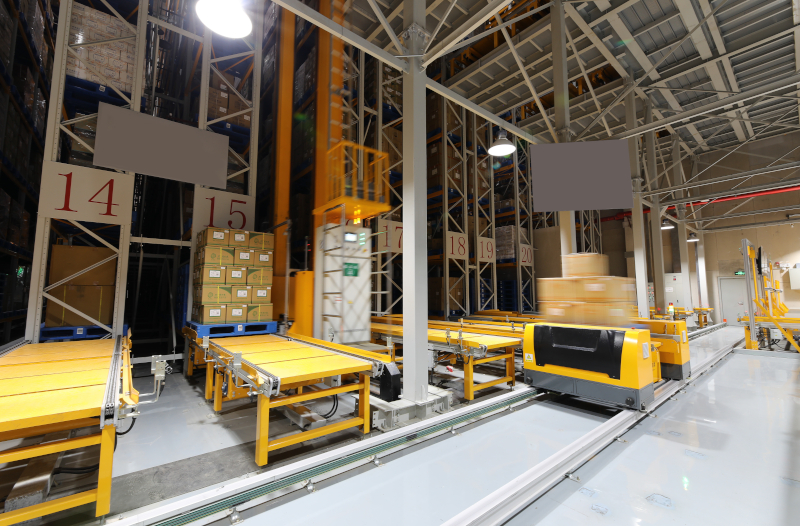Drive Away The Sway for Stacker Cranes
5 October 2022JOON-SUNG LEE, OEM MANAGER, MATERIAL HANDLING, ABB DRIVES, EXPLAINS HOW VARIABLE SPEED DRIVES (VSDS) WITH BUILT-IN ANTI-PENDULUM FUNCTIONALITY CAN OVERCOME OSCILLATION PROBLEMS FOR TALL STACKER CRANES.
Warehouses play a crucial role in the modern economy, and operators face constant pressure to work faster and more efficiently. To reduce material handling times and operational costs, automated storage and retrieval systems (AS/RS) have come to dominate the intralogistics industry. A common feature of these systems is the automated stacker crane.
Stacker cranes that operate on rails in narrow aisles have become popular because they are effective, safe, and relatively inexpensive. Now, warehouse operators are installing taller, faster, and lighter-weight stacker cranes – but this has created a new problem: “sway”.
The swaying problem
As these large, fast-moving machines operate, the inherent flexibility in their frames mean they can move, swaying from their normal position. In this way, they act as an inverted pendulum. If this is not kept under control, a stacker crane can suffer instability and loss of positional accuracy. In severe cases, this oscillation can also compromise safety and cause damage to the crane itself or surrounding infrastructure.
The movement involved can be significant. For example, a 35m tall stacker crane running at full speed can sway by around 1m in the axis of travel. The sway can last for more than ten seconds. It is not safe for the crane to store or retrieve a pallet while it is swaying, so this reduces the system’s throughput. One way to address this issue would be to operate the cranes more slowly, but this isn’t an attractive option as it would also reduce productivity. Another solution is to apply more precise and smarter control to the motors that move the crane.
Anti-pendulum drive control
Variable Speed Drives (VSDs) control the torque and speed of the motors powering the stacker cranes. Reduced swing can be achieved by utilizing drives with an integrated anti-pendulum function. This works by creating a mathematical model of the crane’s movement and the load’s height and mass and then adjusting the output to counteract sway.
As the actual height of the load changes when the crane moves, the function automatically recalculates the required motor speed and torque to compensate for the crane’s changing center of gravity.
Damping injection actively counters any residual sway or speed errors as the crane moves to reach its target position. As a result, the crane’s oscillation lasts less than a few hundred milliseconds. This minimizes wait time and improves warehouse productivity safely.
Choosing the right drives
By specifying appropriate drives for use with stacker cranes, facilities can overcome issues with pendulum movement as well as reduce overall energy consumption.
ABB’s ACS880 drives family is designed for crane applications. The ACS880-11 regenerative drive is designed to control the hoist (y-axis). It can take the place of the large, expensive, and heat-dissipating braking resistors that have traditionally been used.
As a regenerative drive, the ACS880-11 can feed the braking power back to the network. It draws power to lift the hoist, but then returns a fraction of it as it lowers. This makes use of energy that would ordinarily go to waste, reducing the system’s total energy consumption. An added benefit is that this produces less waste heat, making temperature control simpler. This is particularly important in cold chain facilities.
Another major benefit of the regenerative drives is their low harmonic content. Harmonics introduced by motors and drives can cause higher electrical losses, overheating and issues for other devices on the network. To prevent this, system integrators may use active/passive filters and often choose oversized electrical equipment, such as transformers, cables, switchgears, circuit breakers, and more. This results in additional costs and inefficient use of space within the warehouse.
Choosing drives with low harmonic content eliminates the need for oversized components elsewhere. This, combined with the potential for anti-pendulum features to enable taller cranes, can contribute to lower construction and operational costs.
For travel along the rails (x-axis), the standard ACS880-01 wall-mounted drive or ACS880-M04 drive module are ideal. They are cost effective as they use small resistors, and they include built-in anti-pendulum features, so no additional controllers or sensors are required. This enables the drive to deliver quick, accurate, robust and safe control with minimal effort.
ABB’s TÜV-certified safety functions modules are easy to integrate into ACS880 drives, adding benefits such as Safely-Limited Speed (SLS), Safe Stop Emergency (SSE) and Safe Brake Control (SBC). Controlling safety functions over a safety fieldbus (PROFISAFE) reduces cabling needs. Where there are additional requirements, the AC500-S safety programmable logic controller can further safely monitor variables such as torque, acceleration, position, and more.
For the forks which retrieve and place the pallets (z-axis), the ACS380 machinery drive is an appropriate choice. The compact size of this drive is well suited to warehouse applications as the units does not take up valuable space. Despite its small size, its combination of excellent motor control performance and basic crane features further enhances machine performance.
Putting an end to the sway issue
Anti-pendulum variable speed drives enable a facility to operate cranes efficiently at high speeds, maximizing throughput without compromising safety. Facilities that use this technology will secure a major advantage in a competitive industry.
To learn more, visit https://new.abb.com/drives/segments/stacker-cranes
ABB (ABBN: SIX Swiss Ex) is a leading global technology company that energizes the transformation of society and industry to achieve a more productive, sustainable future. By connecting software to its electrification, robotics, automation and motion portfolio, ABB pushes the boundaries of technology to drive performance to new levels. With a history of excellence stretching back more than 130 years, ABB’s success is driven by about 105,000 talented employees in over 100 countries. www.abb.com


